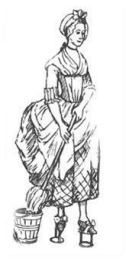
A shoe is an item of footwear intended to protect and comfort the human foot. Though the human foot can adapt to varied terrains and climate conditions, it is vulnerable, and shoes provide protection. Form was originally tied to function, but over time, shoes also became fashion items. Some shoes are worn as safety equipment, such as steel-toe boots, which are required footwear at industrial worksites.

Footwear refers to garments worn on the feet, which typically serve the purpose of protection against adversities of the environment such as wear from rough ground; stability on slippery ground; and temperature.

The Wellington boot, often shortened to welly and also known as the gumboot, is a type of waterproof boot.

Clogs are a type of footwear made in part or completely from wood. Used in many parts of the world, their forms can vary by culture, but often remained unchanged for centuries within a culture.

The Worshipful Company of Pattenmakers is one of the Livery Companies of the City of London. The Pattenmakers, who were incorporated by Royal Charter in 1670, were makers of wooden-soled overshoes. Pattens in previous times were helpful to pedestrians negotiating the muddy streets of London. However, with the advent of paved streets and rubber galoshes, pattens became obsolete by the end of the 19th century. Thus, the company's main function is now as a charitable body rather than a guild or trade association for pattenmakers.

Geta (下駄) are traditional Japanese footwear resembling flip-flops. A kind of sandal, geta have a flat wooden base elevated with up to three "teeth", held on the foot with a fabric thong, which keeps the foot raised above the ground.
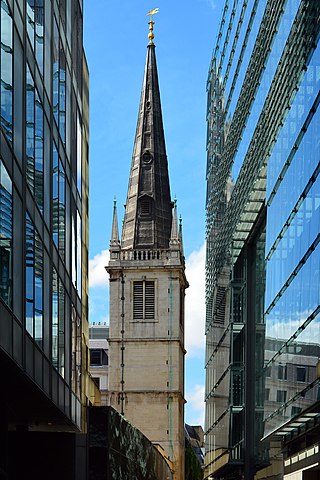
St Margaret Pattens is a Church of England church in the City of London, located on Eastcheap near the Monument. The dedication is to Saint Margaret of Antioch.
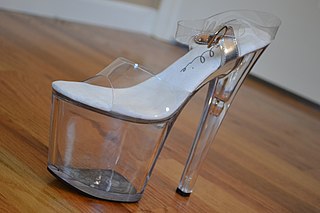
Platform shoes are shoes, boots, or sandals with a thick sole, usually in the range of 5–10 cm (2–4 in). Platform shoes may also be high heels, in which case the heel is raised significantly higher than the ball of the foot. Extreme heights, of both the sole and heel, can be found in fetish footwear such as ballet boots, where the sole may be up to 20 cm (8 in) high and the heels up to 40 cm (16 in) or more. The sole of a platform shoe can have a continuous uniform thickness, have a wedge, a separate block or a stiletto heel. Raising the ankle increases the risk of a sprained ankle.

Sandals are an open type of shoe, consisting of a sole held to the wearer's foot by straps going over the instep and around the ankle. Sandals can also have a heel. While the distinction between sandals and other types of footwear can sometimes be blurry, the common understanding is that a sandal leaves all or most of the foot exposed. People may choose to wear sandals for several reasons, among them comfort in warm weather, economy, and as a fashion choice. Usually, people wear sandals in warmer climates or during warmer parts of the year in order to keep their feet cool and dry. The risk of developing athlete's foot is lower than with enclosed shoes, and the wearing of sandals may be part of the treatment regimen for such an infection.

Galoshes, also known by many other names, are a type of overshoe or rubber boot that is put on over shoes to keep them from getting muddy or wet during inclement weather.
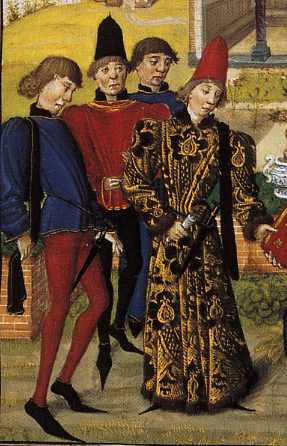
Poulaines, also known by other names, were a style of unisex footwear with extremely long toes that were fashionable in Europe at various times in the Middle Ages. The poulaine proper was a shoe or boot of soft material whose elongated toe frequently required filling to maintain its shape. The chief vogue for poulaines spread across Europe from medieval Poland in the mid-14th century and spread across Europe, reaching upper-class England with the 1382 marriage of Richard II to Anne of Bohemia and remaining popular through most of the 15th century. Sturdier forms were used as overshoes and the sabatons of the era's armor were often done in poulaine style. Poulaines were periodically condemned by Christian writers of the time as demonic or vain. Kings of the era variously taxed them as luxuries, restricted their use to the nobility, or outright banned them. After becoming more common as women's footwear and expanding to awkward lengths, poulaines fell from fashion in the 1480s and were seldom revived, although they are considered an influence on some later trends such as the 1950s British winklepicker boots.

A dress shoe is a shoe to be worn at smart casual or more formal events. A dress shoe is typically contrasted to an athletic shoe.
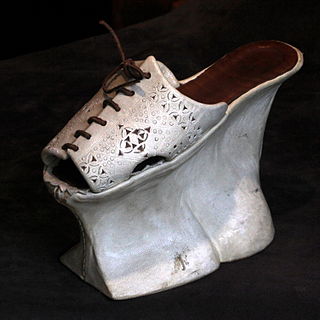
A chopine is a type of women's platform shoe that was popular in the 15th, 16th and 17th centuries. Chopines were originally used as a patten, clog, or overshoe to protect shoes and dresses from mud and street soil.

Jika-tabi are a style of footwear with a divided toe, originating in Japan. They are similar to tabi socks in both appearance and construction. Though they can be worn with traditional thonged footwear such as geta and zōri, jika-tabi are mostly designed and made to be worn alone as outdoor footwear, resembling boots that reach roughly to the mid-calf. Jika-tabi are also known as 'tabi boots'.

Fashion in fourteenth-century Europe was marked by the beginning of a period of experimentation with different forms of clothing. Costume historian James Laver suggests that the mid-14th century marks the emergence of recognizable "fashion" in clothing, in which Fernand Braudel concurs. The draped garments and straight seams of previous centuries were replaced by curved seams and the beginnings of tailoring, which allowed clothing to more closely fit the human form. Also, the use of lacing and buttons allowed a more snug fit to clothing.
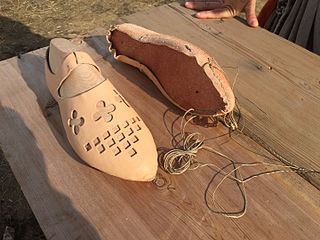
A turnshoe is a type of leather shoe that was used during the Middle Ages. It was so named because it was put together inside out, and then was turned right-side-out once finished: this hides the main seam between the sole and vamp—prolonging the life of the shoe and inhibiting moisture leaking in through the seam.

Cleats or studs are protrusions on the sole of a shoe or on an external attachment to a shoe that provide additional traction on a soft or slippery surface. They can be conical or blade-like in shape and can be made of plastic, rubber or metal. The type worn depends on the environment of play: grass, ice, artificial turf, or other grounds.

A British clog is a wooden-soled clog from Great Britain. The uppers are typically leather, and many variations exist in style and fastening.

A duckbill, bearpaw or cow's mouth was a style of shoe with a broad toe which was fashionable in the 15th and 16th centuries. This style started with Charles VIII of France, who had an extra toe, and was later worn by Henry VIII of England. It replaced the excessively long toe of the poulaine but also tended to become impractical, as it became enlarged with stuffing and horns and so could be a foot wide, giving the wearer a waddling gait. It might also be adorned with slashes to show the fine lining and sumptuary laws were introduced to restrict all these excesses. Duckbill shoes were rounded like a duck's bill; cowsmouth shoes widened abruptly at the toes; and bearsclaw shoes had slashes parallel to the toes, so the toe could expand laterally.
Clogs have traditionally been used in Turkish bath houses to protect the foot from dirty water and soap. The earlier form were called "nalins" and originated during the Ottoman period. Nalins came to be artistic objects which indicated the wearer's social standing. As domestic baths became more common the rituals of the bath house declined and nalins were replaced with the simpler "takunya". Takunya are also worn outside of the bath house. Since 1960 takunya have in their turn been replaced by plastic slippers which are lighter and quieter.




